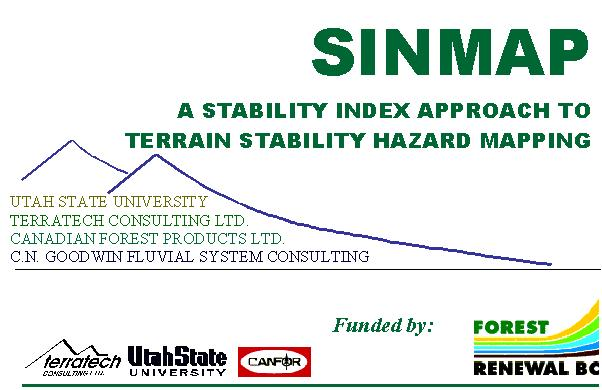SINMAP

SINMAP (Stability Index MAPping) is an ArcView extension that implements the computation and mapping of a slope stability index based upon geographic information, primarily digital elevation data. SINMAP has its theoretical basis in the infinite plane slope stability model with wetness (pore pressures) obtained from a topographically based steady state model of hydrology. Digital elevation model (DEM) data along with soils data form the basis for the slope stability modeling. Geographic Information System methods are used to obtain the necessary input information (slope and specific catchment area). Parameters are allowed to be uncertain following uniform distributions between specified limits. These may be adjusted (and calibrated) for geographic “calibration regions” based upon soil, vegetation or geologic data. The methodology includes an interactive visual calibration that adjusts parameters while referring to observed landslides. The calibration involves adjustment of parameters so that the stability map “captures” a high proportion of observed landslides in regions with low stability index, while minimizing the extent of low stability regions and consequent alienation of terrain to regions where landslides have not been observed. This calibration is done while simultaneously referring to the stability index map, a specific catchment area and slope plot (of landslide and non landslide points) where lines distinguish the zones categorized into the different stability classes and a table giving summary statistics.
SINMAP is available for the Windows NT and Windows 95 operating systems. It utilizes the ArcView geographic information system (GIS) from Environmental Systems Research Institute, Inc. (ESRI) for its standard GIS functionality and requires the following versions (or higher) of:
- ArcView GIS Version 3.0a for Windows
- ArcView GIS Spatial Analyst Version 1.0a for Windows
Source code is also included for those who may not have these products or want to try implement the system on a different system.
Distribution
The distribution comprises the following:
sinmap.zip. (1600KB) All inclusive zip file. Click here and get the whole package, or explore individual pieces below.
sinmaplight.zip. (84KB) A zip file with only the program files sinmap.avx and sinmap.dll. sinmap.avx is the ArcView extension file used by SINMAP. This file must be placed in the directory called arcview/ext32, which is the standard location for ArcView extension files. sinmap.dll is the binary dynamic link library file containing SINMAP routines. It must be placed in the arcview/bin32 directory where arcview.exe and all ArcView DLL files are located.
sinmap.pdf. (1335KB) Copy of the user's manual in Adobe Acrobat format. This document also includes 3 case studies in British Columbia. To read this you need the free Adobe Acrobat (TM) Reader.
example.zip. (314KB) A zip file containing the following four files that comprise a small test example.
- sample.asc. ASCII file of digital elevation model data.
- samplels.shx,samplels.dbf. ArcView shape files for point landslide sample data. All 3 files comprise ONE shape file.
sampleimage.zip. (16808 KB). Orthoimage geotiff file (with a 1 m pixel size) of the sample.zip sample area.
Version
This CD contains version 1.0d, released January 9, 1999.
To check for later versions visit https://uwrl.usu.edu/hydrology/sinmap/index.php
Publications
- Pack, R. T., D. G. Tarboton and C. N. Goodwin, (1998), "The SINMAP Approach to Terrain Stability Mapping," Paper Submitted to 8th Congress of the International Association of Engineering Geology, Vancouver, British Columbia, Canada 21-25 September 1998. (Adobe PDF 328 KB)
- Pack, R. T., D. G. Tarboton and C. N. Goodwin, (1998), "Terrain Stability Mapping with SINMAP, technical description and users guide for version 1.00," Report Number 4114-0, Terratech Consulting Ltd., Salmon Arm, B.C., Canada. (Adobe PDF 1336 KB)
Acknowledgements
SINMAP was developed with the support of Forest Renewal British Columbia, in collaboration with Canadian Forest Products Ltd., Vancouver, British Columbia. These programs were developed with government funding and are in the public domain, not subject to copyright. They are distributed freely with the following requests.
- In any publication arising from the use for research purposes, the source of the program should be properly acknowledged and a pre-print of the publication sent to the developers at the address below.
- In any use for commercial purposes or inclusion in any commercial software, appropriate acknowledgement is to be included and a free copy of this software made available to the authors at the address below.
Support
There is no formal ongoing support for this freely distributed public domain software. However, we are interested in feedback and can help to the extent that our time permits. If you find errors, have suggestions, or are interested in any later versions contact:
Robert T. Pack
Utah State University
Logan, Utah 84322-4110
USA
Phone: 435-797-7049
Fax: 435-797-1185
email: rtpack@lab.cee.usu.edu
David Tarboton
Utah State University
Logan, UT, 84322-8200
USA
Phone: 435-797-3172
Fax: 435-797-3663
email: dtarb@cc.usu.edu

